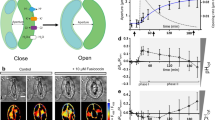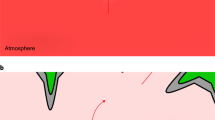Abstract
INTRACELLULAR electrical recordings in onion guard cells show that they maintain a membrane potential difference (MPD), inside negative. The MPD is light-sensitive; cells subjected to short light and dark cycles depolarise in the dark and hyperpolarise in the light. The swiftness of the electrical changes makes them among the fastest known stomatal responses, suggesting a causal relationship between the reception of light, the changes in membrane potential and the ion fluxes known to be associated with stomatal movement. The magnitude and electrical sign of the responses are consistent with the activity of a light-sensitive proton pump which would provide the driving force for ion transport across the cell membrane. Guard cells, the specialised structures that control gas exchange in the leaves of higher plants, use potassium to modulate their intracellular osmotic potential and perform the mechanical work needed to open and close the stomatal pore1. When guard cells accumulate K+ (with intracellular concentrations reaching up to 0.5 M (refs 2 and 3)), water content increases and swelling occurs, causing the pore to open. During the reverse process, K+ is extruded (intracellular concentration diminishes to 0.1 M (refs 2 and 3)), leading to water loss and pore closure. Control of intracellular K+ concentrations is a universal feature of living organisms. Nerve cells sore energy used to generate electrical signals by maintaining concentration gradients of Na+ and K+ (ref. 4); bacterial cells selectively accumulate K+ (ref. 5) and, in plants, cells expand by increasing their turgor through uptake of K+ and its counter-ions6. While the cellular basis of K+ uptake in stomatal guard cells is poorly understood, one might expect common mechanisms for K+ transport even in widely divergent species. Two distinct mechanisms for K+ transport have been defined. In one, common in animal cells, K+ uptake is driven by ATP through a Na+/K+ ATPase7; in the second system, demonstrated in bacteria, ion transport is conducted by a proton-motive force8 generated by pH and electrical potential gradients across the membrane9. In showing that wall-less guard cell protoplasts swell when illuminated, we previously argued that a proton-motive force could drive K+ uptake into the guard cells10. The hypothesis generates the basic prediction of a light-sensitive, inside negative, MPD across the guard cell membrane. We report here the experimental verification of that prediction, through intracellular recordings in guard cells of Allium cepa.
This is a preview of subscription content, access via your institution
Access options
Subscribe to this journal
Receive 51 print issues and online access
$199.00 per year
only $3.90 per issue
Buy this article
- Purchase on Springer Link
- Instant access to full article PDF
Prices may be subject to local taxes which are calculated during checkout
Similar content being viewed by others
References
Hsiao, T. C. in Encyclopedia of Plant Physiology, Part B (eds Lüttge, U. & Pitman, M. G.) 2, 195–221 (Springer, Berlin, 1976).
Sawhney, B. L. & Zelitch, I. Pl. Physiol. 44, 1350–1354 (1969).
Penny, M. G. & Bowling, D. J. F. Planta 119, 17–25 (1974).
Hodgkin, A. L. & Keynes, R. D. J. Physiol. Lond. 128, 28–60 (1955).
Harold, F. M. Bact. Rev. 36, 172–230 (1972).
Cram, W. J. in Encyclopedia of Plant Physiology, Part A (eds Lüttge, U. & Pitman, M. G.) 2, 284–316 (1976).
Hokin, L. E. & Dahl, J. L. in Metabolic Pathways (ed. Hokin, L. E.) 6, 270–315 (Academic, New York, 1972).
Mitchell, P. Biol. Rev. 41, 445–502 (1966).
Rhoads, D. B. & Epstein, W. J. biol. Chem. 252, 1394–1401 (1977).
Zeiger, E. & Hepler, P. K. Science 196, 887–889 (1977).
Moody, W. & Zeiger, E. Planta (in the press).
Zeiger, E. & Hepler, P. K. Pl. Physiol. 58, 492–498 (1976).
Raschke, K. Pl. Physiol. 49, 229–234 (1972).
Raschke, K. A. Rev. Pl. Physiol. 26, 309–340 (1975).
Pallaghy, C. K. Planta 80, 147–163 (1968).
Gunar, I. I., Zlotnikova, I. F. & Panichkin, L. A. Sov. Pl. Physiol. 22, 704–707 (1975).
Hagins, W. A. A. Rev. Biophys. Bioengin. 1, 131–158 (1972).
Brodie, A. E. & Bownds, D. J. gen. Physiol. 68, 1–11 (1976).
Garty, H. & Caplan, S. R. Biochim. biophys. Acta 459, 532–545 (1977).
Bogomolni, R. A. Fedn Proc. 36, 1833–1839 (1977).
Skulachev, V. FEBS Lett. 74, 1–9 (1977).
Michel, H. & Oesterhelt, D. FEBS Lett. 65, 175–178 (1976).
Author information
Authors and Affiliations
Rights and permissions
About this article
Cite this article
ZEIGER, E., MOODY, W., HEPLER, P. et al. Light-sensitive membrane potentials in onion guard cells. Nature 270, 270–271 (1977). https://doi.org/10.1038/270270a0
Received:
Accepted:
Issue Date:
DOI: https://doi.org/10.1038/270270a0
This article is cited by
-
Blue light-dependent proton extrusion by guard-cell protoplasts of Vicia faba
Nature (1986)
-
Blue light activates electrogenic ion pumping in guard cell protoplasts of Vicia faba
Nature (1985)
-
Potassium-selective single channels in guard cell protoplasts of Vicia faba
Nature (1984)
-
Regular arrays of intramembranous particles in the plasmalemma of guard cell and mesophyll cell protoplasts of Vicia faba
Planta (1980)
Comments
By submitting a comment you agree to abide by our Terms and Community Guidelines. If you find something abusive or that does not comply with our terms or guidelines please flag it as inappropriate.



